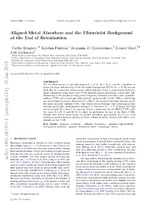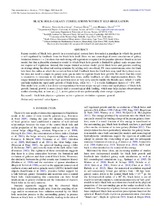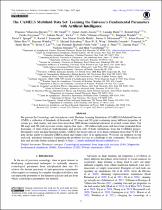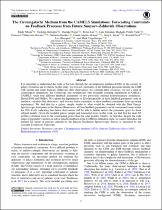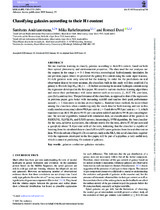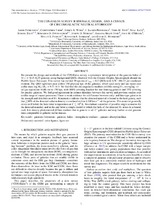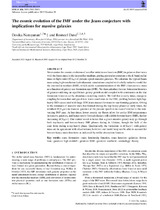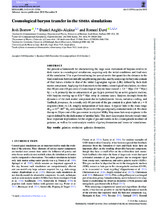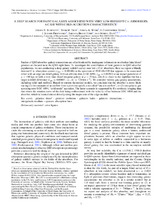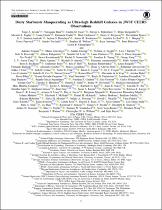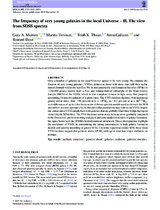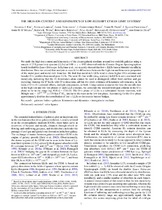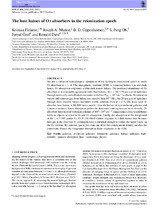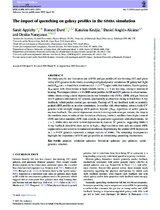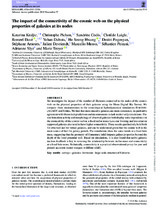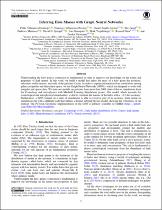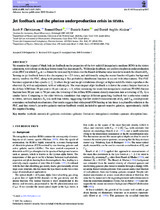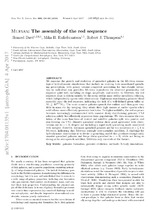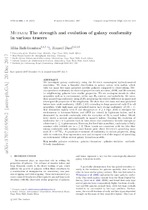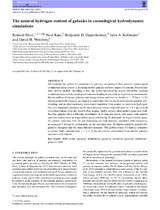Browsing Research Articles (Physics) by Author "Dave, Romeel"
Now showing items 1-20 of 35
-
Aligned metal absorbers and the ultraviolet background at the end of reionization
Doughty, Caitlin; Finlator, Kristian; Oppenheimer, Benjamin D.; Dave, Romeel; Zackrisson, Erik (Oxford University Press, 2018)We use observations of spatially-aligned C ii, C iv, Si ii, Si iv, and O i absorbers to probe the slope and intensity of the ultraviolet background (UVB) at z ∼ 6. We accom- plish this by comparing observations with ... -
Black hole - galaxy correlations without self-regulation
Angles-Alcazar, Daniel; Ozel, Feryal; Dave, Romeel (American Astronomical Society, 2013)Recent models of black hole growth in a cosmological context have forwarded a paradigm in which the growth is self-regulated by feedback from the black hole itself. Here we use cosmological zoom simulations of galaxy formation ... -
The CAMELS multifield data set: Learning the universe’s fundamental parameters with artificial intelligence
Shy, Genel; Villaescusa-Navarro, Fransisco; Anglés-Alcázar, Daniel; Dave, Romeel; Hassan, Sultan (IOP, 2022)We present the Cosmology and Astrophysics with Machine Learning Simulations (CAMELS) Multifield Data set (CMD), a collection of hundreds of thousands of 2D maps and 3D grids containing many different properties of cosmic ... -
The circumgalactic medium from the camels simulations: Forecasting constraints on feedback processes from future Sunyaev–Zeldovich observations
Moser, Emily; Battaglia, Nicholas; Dave, Romeel (IOP Publishing, 2022)It is important to understand the cycle of baryons through the circumgalactic medium (CGM) in the context of galaxy formation and evolution. In this study, we forecast constraints on the feedback processes heating the ... -
Classifying galaxies according to their H I content
Andrianomena, Sambatra; Rafieferantsoa, Mika; Dave, Romeel (Oxford University Press, 2020)We use machine learning to classify galaxies according to their H I content, based on both their optical photometry and environmental properties. The data used for our analyses are the outputs in the range z = 0–1 from ... -
The COS-Halos survey: Rationale, design and a census of circumgalactic neutral hydrogen
Tumlinson, Jason; Thom, Christopher; Dave, Romeel; Werk, Jessica K.; Prochaska, J. Xavier; Tripp, Todd M.; Katz, Neal; Oppenheimer, Benjamin D.; Meiring, Joseph D.; Ford, Amanda Brady; O'Meara, John M.; Peeples, Molly S.; Sembach, Kenneth R.; Weinberg, David H. (IOP Publishing, 2013)We present the design and methods of the COS-Halos survey, a systematic investigation of the gaseous halos of 44 z = 0.15–0.35 galaxies using background QSOs observed with the Cosmic Origins Spectrograph aboard the Hubble ... -
The cosmic evolution of the IMF under the Jeans conjecture with implications for massive galaxies
Narayanan, Desika; Dave, Romeel (Oxford University Press, 2013)We examine the cosmic evolution of a stellar initial mass function (IMF) in galaxies that varies with the Jeans mass in the interstellar medium, paying particular attention to the K-band stellar mass-to-light ratio (M/LK) ... -
Cosmological baryon transfer in the SIMBA simulations
Dave, Romeel; Borrow, Josh; Angles-Alcazar, Daniel (Oxford University Press, 2019)We present a framework for characterizing the large-scale movement of baryons relative to dark matter in cosmological simulations, requiring only the initial conditions and final state of the simulation. This is performed ... -
A deep search for faint galaxies associated with very low-redshift C iv absorbers: A case with cold-accretion characteristics
Burchett, Joseph N.; Tripp, Todd M.; Werk, Jessica K.; Howk, J. Christopher; Dave, Romeel; Prochaska, J. Xavier; Ford, Amanda Brady (The American Astronomical Society, 2013)Studies of QSO absorber–galaxy connections are often hindered by inadequate information on whether faint/dwarf galaxies are located near the QSO sight lines. To investigate the contribution of faint galaxies to QSO ... -
Dusty starbursts masquerading as ultra-high redshift galaxies in jwst ceers observations
Fontana, Adriano; Giavalisco, Mauro; Dave, Romeel (American Astronomical Society, 2023)Lyman-break galaxy (LBG) candidates at z 10 are rapidly being identified in James Webb Space Telescope (JWST)/NIRCam observations. Due to the (redshifted) break produced by neutral hydrogen absorption of restframe UV ... -
The frequency of very young galaxies in the local Universe – II. The view from SDSS spectra
Dave, Romeel; Mamon, Gary A.; Trevisan, Marina (Oxford University Press, 2019)Only a handful of galaxies in the local Universe appear to be very young. We estimate the fraction of very young galaxies (VYGs), defined as those with more than half their stellar masses formed within the last Gyr. We fit ... -
The high-ion content and kinematics of low-redshift lyman limit systems
Fox, Andrew J.; Lehner, Nicholas; Dave, Romeel; Tumlinson, Jason; Howk, J. Christopher; Tripp, Todd M.; Prochaska, J. Xavier; O'Meara, John M.; Werk, Jessica K.; Bordoloi, Rongmon; Katz, Neal; Oppenheimer, Benjamin D. (The American Astronomical Society, 2013)We study the high-ion content and kinematics of the circumgalactic medium around low-redshift galaxies using a sample of 23 Lyman limit systems (LLSs) at 0.08 < z < 0.93 observed with the Cosmic Origins Spectrograph on ... -
The host haloes of O I absorbers in the reionization epoch
Finlator, Kristian; Muñoz, Joseph A.; Dave, Romeel; Oppenheimer, B. D.; Peng Oh, S.; Özel, Feryal (Oxford University Press, 2013)We use a radiation hydrodynamic simulation of the hydrogen reionization epoch to study OI absorbers at z ∼ 6. The intergalactic medium (IGM) is reionized before it is enriched; hence, OI absorption originates within dark ... -
The impact of quenching on galaxy profiles in the SIMBA simulation
Dave, Romeel; Appleby, Sarah; Kraljic, Katarina (Oxford University Press, 2020)We study specific star formation rate (sSFR) and gas profiles of star-forming (SF) and green valley (GV) galaxies in the SIMBA cosmological hydrodynamic simulation. SF galaxy half-light radii (Rhalf) at z = 0 and their ... -
The impact of the connectivity of the cosmic web on the physical properties of galaxies at its nodes
Dave, Romeel; Kraljic, Katarina; Pichon, Christophe (Oxford University Press, 2019)We investigate the impact of the number of filaments connected to the nodes of the cosmic web on the physical properties of their galaxies using the Sloan Digital Sky Survey. We compare these measurements to the cosmological ... -
Inferring halo masses with graph neural networks
Villanueva-Domingo, Pablo; Villaescusa-Navarro, Francisco; Dave, Romeel (Institute of Physics, 2022)Understanding the halo–galaxy connection is fundamental in order to improve our knowledge on the nature and properties of dark matter. In this work, we build a model that infers the mass of a halo given the positions, ... -
Jet feedback and the photon underproduction crisis in SIMBA
Dave, Romeel; Christiansen, Jacob; Sorini, Daniele; Angles-Alc ´ azar, Daniel (Oxford University Press, 2020-10-01)We examine the impact of black hole jet feedback on the properties of the low-redshift intergalactic medium (IGM) in the SIMBA simulation, with a focus on the Lyα forest mean flux decrement DA. Without jet feedback, we ... -
Mufasa: The assembly of the red sequence
Dave, Romeel; Rafieferantso, Mika H.; Thompson, Robert J. (Oxford University Press, 2017)We examine the growth and evolution of quenched galaxies in the Mufasa cosmo- logical hydrodynamic simulations that include an evolving halo mass-based quench- ing prescription, with galaxy colours computed accounting ... -
MUFASA: The strength and evolution of galaxy conformity in various tracers
Rafieferantsoa, Mika H.; Dave, Romeel (Oxford University Press, 2017)We investigate galaxy conformity using the Mufasa cosmological hydrodynamical simulation. We show a bimodal distribution in galaxy colour with radius, albeit with too many low-mass quenched satellite galaxies compared ... -
The neutral hydrogen content of galaxies in cosmological hydrodynamic simulations
Dave, Romeel; Katz, Neal; Oppenheimer, Benjamin D.; Kollmeier, Juna A.; Weinberg, David H. (Oxford University Press, 2013)We examine the global HI properties of galaxies in quarter billion particle cosmological simulations using GADGET-2, focusing on howgalactic outflows impactHI content.We consider four outflow models, including a new one ...

